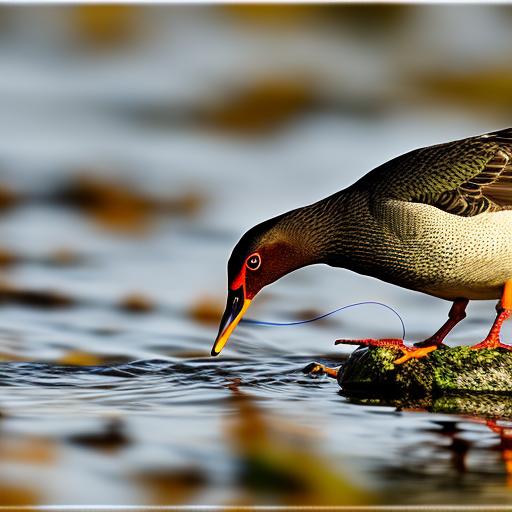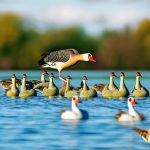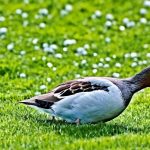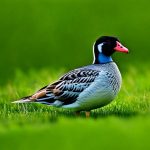Geese infestation is a growing problem in many areas, causing significant damage to the environment and posing health risks to humans. These large birds are known for their aggressive behavior, especially during nesting season, and their droppings can create unsightly and unsanitary conditions. Geese also consume large amounts of vegetation, leading to the destruction of lawns, golf courses, and agricultural fields.
One effective and humane method of deterring geese is the use of fishing line. This simple yet innovative solution acts as a visual and physical barrier, preventing geese from landing or nesting in unwanted areas. Fishing line is an affordable and environmentally friendly option that has been proven to be highly effective in deterring geese without causing harm to the birds.
Key Takeaways
- Geese infestation is a common problem that can cause damage to property and pose health risks.
- Fishing line can be an effective and humane way to deter geese from an area.
- Understanding geese behavior is important in using fishing line as a deterrent.
- Monofilament and braided fishing lines are effective in keeping geese away.
- Proper installation and maintenance of fishing line is crucial for its effectiveness as a deterrent.
The Role of Fishing Line in Deterring Geese
Fishing line works as a deterrent for geese by creating a visual and physical barrier that disrupts their perception and prevents them from landing or nesting in an area. When properly installed, the fishing line is almost invisible to humans but highly visible to geese due to their keen eyesight. The presence of the fishing line creates an illusion of an obstacle that the geese are unable or unwilling to cross.
In addition to its visual deterrent effect, fishing line also acts as a physical barrier for geese. The thin and flexible nature of the fishing line makes it difficult for geese to land or walk on surfaces where it is installed. The fishing line creates an unstable surface that is uncomfortable for the birds, discouraging them from staying in the area.
Understanding the Behavior of Geese and How Fishing Line Works
To effectively deter geese using fishing line, it is important to understand their behavior and how they perceive their environment. Geese are social animals that prefer open spaces near water bodies for nesting and feeding. They have excellent eyesight and are able to detect potential threats from a distance.
Fishing line disrupts the geese’s perception by creating an illusion of an obstacle that they are unable or unwilling to cross. Geese perceive the fishing line as a physical barrier due to its visibility and the way it moves in the wind. This perception prevents them from landing or nesting in an area, as they perceive it as unsafe or inaccessible.
Types of Fishing Line that are Effective in Keeping Geese Away
There are several types of fishing line that are commonly used for deterring geese. Monofilament fishing line is the most popular choice due to its strength, durability, and flexibility. It is available in various thicknesses, with thicker lines being more visible and effective in deterring geese.
Another type of fishing line that is effective in keeping geese away is braided fishing line. This type of line is made up of multiple strands woven together, making it stronger and more resistant to breaking. Braided fishing line is also highly visible, making it an effective deterrent for geese.
How to Install Fishing Line to Keep Geese Away
Installing fishing line as a deterrent for geese is a relatively simple process that can be done by anyone. Here are step-by-step instructions on how to install fishing line:
1. Determine the areas where you want to deter geese from landing or nesting.
2. Measure the length of fishing line needed for each area.
3. Attach one end of the fishing line to a secure anchor point, such as a tree or post.
4. Stretch the fishing line across the area, making sure it is taut and at a height that is visible to geese.
5. Secure the other end of the fishing line to another anchor point.
6. Repeat this process for each area you want to deter geese from.
It is important to place the fishing line at a height that is visible to geese, typically around 2-3 feet above the ground. The fishing line should be installed in a grid pattern, with lines spaced approximately 2-3 feet apart. This ensures that geese are unable to find gaps or openings to land or nest in the area.
Tips for Maintaining Fishing Line as a Deterrent for Geese

To ensure the effectiveness of fishing line as a deterrent for geese, it is important to regularly check and maintain the line. Here are some tips for maintaining fishing line:
1. Regularly inspect the fishing line for any damage or wear.
2. Replace any damaged or worn sections of fishing line.
3. Keep the fishing line taut and at the proper height.
4. Remove any debris or vegetation that may interfere with the fishing line.
5. Regularly monitor the area for any signs of geese or nesting activity.
By regularly maintaining the fishing line, you can ensure that it remains an effective deterrent for geese and prevents them from landing or nesting in unwanted areas.
Advantages and Disadvantages of Using Fishing Line to Keep Geese Away
Using fishing line as a deterrent for geese has several advantages over other methods. Firstly, it is a humane option that does not cause harm to the birds. Unlike other methods such as trapping or shooting, fishing line simply creates an obstacle that prevents geese from landing or nesting in an area.
Secondly, fishing line is an affordable and environmentally friendly option. It is readily available at sporting goods stores and online retailers, and it can be easily installed by anyone without the need for specialized equipment or training. Fishing line also does not pose any risks to other wildlife or the environment.
However, there are some potential drawbacks to using fishing line as a deterrent for geese. One potential drawback is that it may not be effective in all situations. Geese are intelligent animals and may find ways to navigate around or through the fishing line. Additionally, fishing line may not be suitable for areas with heavy foot traffic, as it can pose a tripping hazard.
Other Methods of Deterring Geese and How They Compare to Fishing Line
There are several other methods of deterring geese, such as the use of decoys, noise makers, and chemical repellents. Decoys, such as plastic owls or coyotes, can be effective in deterring geese by creating the illusion of a predator. Noise makers, such as propane cannons or ultrasonic devices, can also be effective in scaring geese away.
However, these methods have their limitations. Decoys may lose their effectiveness over time as geese become accustomed to them. Noise makers can be disruptive to humans and may not be suitable for residential areas. Chemical repellents can be harmful to the environment and other wildlife.
Compared to these methods, fishing line offers several advantages. It is a non-invasive and non-disruptive option that does not require constant maintenance or monitoring. Fishing line is also more cost-effective and environmentally friendly compared to other methods.
Common Misconceptions about Using Fishing Line as a Deterrent for Geese
There are some common misconceptions about using fishing line as a deterrent for geese that need to be addressed. One misconception is that fishing line may harm birds or other wildlife. However, when properly installed and maintained, fishing line does not pose any risks to birds or other animals. It simply creates an obstacle that prevents geese from landing or nesting in an area.
Another misconception is that fishing line may cause injury to humans or pets. While it is important to install and maintain the fishing line properly to prevent tripping hazards, when done correctly, fishing line does not pose any risks to humans or pets.
Conclusion and Recommendations for Using Fishing Line to Keep Geese Away
In conclusion, fishing line is a humane and effective way to deter geese from landing or nesting in unwanted areas. It creates a visual and physical barrier that disrupts the geese’s perception and prevents them from accessing the area. Fishing line is an affordable and environmentally friendly option that can be easily installed and maintained by anyone.
For those interested in using fishing line as a deterrent for geese, it is recommended to purchase monofilament or braided fishing line from sporting goods stores or online retailers. Follow the step-by-step instructions for installation and regularly check and maintain the fishing line to ensure its effectiveness.
By using fishing line as a deterrent for geese, you can protect your property, maintain a clean and sanitary environment, and prevent damage to the ecosystem.
If you’re looking for effective ways to keep geese away from your property, you might be interested in this informative article on Poultry Wizard. In addition to using fishing line as a deterrent, the article explores various methods for protecting your chickens and chicken coops from geese. Discover how to create a safe and secure environment for your feathered friends by checking out the article here: https://poultrywizard.com/keeping-chickens/chicken-coop-chester-sc/.
FAQs
What is the article about?
The article is about using fishing line as a deterrent to keep geese away.
Why do people want to keep geese away?
Geese can cause damage to property, leave droppings, and be aggressive towards humans.
How does fishing line keep geese away?
Fishing line creates a physical barrier that geese are hesitant to cross, as they perceive it as a potential threat to their safety.
Where should fishing line be placed to keep geese away?
Fishing line should be placed in areas where geese are likely to gather, such as near bodies of water or on lawns.
Is fishing line harmful to geese?
No, fishing line is not harmful to geese. It simply acts as a visual deterrent.
Are there any other methods to keep geese away?
Yes, other methods include using decoys, noise makers, and repellents. However, these methods may not be as effective as fishing line.
Meet Walter, the feathered-friend fanatic of Florida! Nestled in the sunshine state, Walter struts through life with his feathered companions, clucking his way to happiness. With a coop that’s fancier than a five-star hotel, he’s the Don Juan of the chicken world. When he’s not teaching his hens to do the cha-cha, you’ll find him in a heated debate with his prized rooster, Sir Clucks-a-Lot. Walter’s poultry passion is no yolk; he’s the sunny-side-up guy you never knew you needed in your flock of friends!







